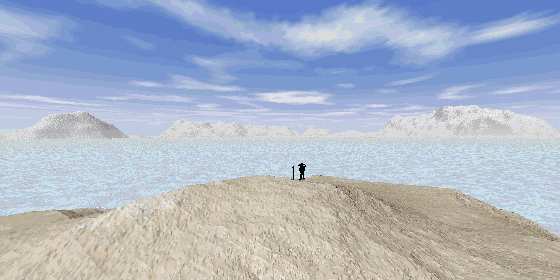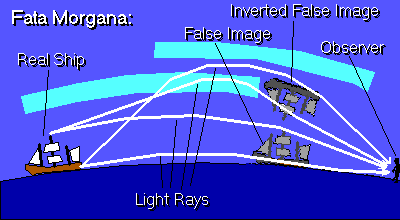pop up description layer
HOME
Cryptozoology UFO Mysteries Aviation Space & Time Dinosaurs Geology Archaeology Exploration 7 Wonders Surprising Science Troubled History Library Laboratory Attic Theater Store Index/Site Map Cyclorama
Search the Site: |
|
Mirages in the Sky
Peary could clearly see the mountain tops of "Crocker Land" across the polar ice pack, but it was only an Arctic Mirage. (Copyright Lee Krystek, 1998) On June 23, 1744, a phantom army appeared floating above a mountain in Scotland. Twenty seven people, who later gave sworn testimony to what they'd seen, watched the strange vision for two hours till it ended with darkness. In the summer of 1897 in Alaska, an expedition to the wilderness near Mount St. Elias saw a "Silent City" over a glacier. A member of the expedition, C. W. Thornton, wrote, "It required no effort of the imagination to liken it to a city, but was so distinct that it required, instead, faith to believe that it was not in reality a city." Another witness reported, "We could plainly see houses, well-defined streets, and trees. Here and there rose tall spires over huge buildings..." The above incidents are examples of a startling optical atmospheric effect known as a mirage. Though we associate mirages with the illusion of distant water in a desert, the phantom oasis is actually just the simplest example of this bizarre effect. A mirage is generated by two layers of air at different temperatures. Because cold air is more dense than hot air, the boundary between the layers can refract (bend) light, especially if the light hits the boundary at an extreme angle. The oasis mirage occurs when the air just above the ground gets hot because the ground heats it.
A mirage can also be the result of a temperature boundary between layers of air in the sky. If the boundary is not flat, but curved, the mirage will not only display a mirror image, but act as a lens, and magnify distant images. Sir David Brewster speculated that the phantom soldiers above the mountain were caused by a mirage that reflected troops on maneuvers on the other side of the mountain from the witnesses. Mirages in the sky may also be the source of many UFO reports. The planet Venus magnified and distorted by a mirage makes a believable flying saucer. Since the properties of the mirage change with the movement of the air masses, objects in the mirage may twinkle, jump around, seem to speed away or disappear. When the effect appears above the water, it is often referred to as a Fata Morgana. The phrase comes from the Italian version of the name of the sorceress Morgan Le Fay from the legends of King Arthur and Camelot. In ancient times these strange effects were considered the work of witchcraft. The schooner Effie M. Morrissey was sailing the North Atlantic on July 17, 1939 when a Fata Morgana appeared. Though the coast of Iceland was some 320 miles away, Captain Bartlett indicated that it appeared as if it was only twenty five miles away. "The contours of the land and the snow-covered summit of the Snaefells Jokull showed up almost unbelievably near." Scientists believe Fata Morganas are most likely to form when the sea is much colder than the atmosphere. As the water cools the air directly above it, a boundary layer forms. These types of mirages are most likely to show up after dawn, before dusk or as a storm is building up. They also tend to favor particular locations. The Straits of Messina, between Sicily and the Italian mainland, are famous for its Fata Morganas. When several boundaries of air are involved, a mirage can become even more complex as the light is refracted multiple times. This can make natural objects, like cliffs, appear as city buildings, or castles. This is probably the best explanation for the Alaskan City mirage, though some contend that it was actually a magnification of the English city of Bristol some 2,500 miles away. The Arctic is famous for mirages and one such image cost the American Museum of Natural History a small fortune. The story started in June of 1906 when Robert E. Peary, who would be the first man to reach the north pole in 1909, was studying the horizon from the summit of Cape Colgate, a point in the extreme northwestern part of North America. Peary wrote that "North stretched the well-known ragged surface of the polar pack and northwest it was with a thrill that my glasses revealed the white summits of a distant land." Peary estimated that this unknown land lay 120 miles offshore and named it "Crocker Land" after one of his financial backers. Seven years later the Museum of Natural History committed $6,000, a significant sum at the time, to outfit an expedition to explore "Crocker Land." On April 13th of that year the group reached a spot near where Peary had spotted the land and set out across the polar ice pack in the direction indicated by Peary. The journey was difficult and dangerous, but after about a week the expedition was treated to a glimpse of this new land when the weather cleared. One of the members wrote later, "we ran to the top of the highest mount. There could be no doubt about it. Great heavens! What a land! Hills, valleys, snow-capped peaks extending through at least one hundred and twenty degrees of horizon." The Eskimos traveling with the expedition were unimpressed and said that the vision was poo-jok, which translates to "mist." The group traveled one more day forward and then took their position using a sextant and the sun. Shocked, they realized they were 150 miles onto the polar ice cap. According to Peary's calculations, they should have been 30 miles inland at that point. The expedition realized that both they and Peary had been fooled by a mirage. Disappointed, they started back. Behind them, though, the mirage persisted, mocking them as they returned. When they reached the point where Peary had seen "Crocker Land" from the shore, they took a look themselves. They reported, "There was land everywhere! Had we not just come from far over the horizon we would have returned to our country and reported land as Peary did." Delays in retrieving the group stretched the length of the expedition to five years and the cost to $100,000. While the trip did result in the collection of much valuable information, it was still considered a failure. All because of an Arctic mirage.
Copyright Lee Krystek 1996, 1998. All Rights Reserved. |
|
Related Links |
|
|




 This
effect can commonly be seen on asphalt roads during the summer.
The black color of the road gets the air above it hot very quickly.
At the boundary of the hot and normal air, light is refracted.
The viewer no longer sees the road or desert floor, but light
refracted from the blue sky which, because it is on the ground,
looks like water.
This
effect can commonly be seen on asphalt roads during the summer.
The black color of the road gets the air above it hot very quickly.
At the boundary of the hot and normal air, light is refracted.
The viewer no longer sees the road or desert floor, but light
refracted from the blue sky which, because it is on the ground,
looks like water.
 Fata
Morganas may also be the cause of legends about phantom ships
that sail the sky. Reports of the ghost ship Flying Dutchman
may well have been the reflection of some distant vessel.
Fata
Morganas may also be the cause of legends about phantom ships
that sail the sky. Reports of the ghost ship Flying Dutchman
may well have been the reflection of some distant vessel.
 The
illustration at the left is a computer-generated simulation
of a mirage. A program capable of accurately rendering an image
was given the position of the ground, a partly-refractive boundary
layer in the sky and a ship model. Between the observer position
and the ship was also placed a mountain. The ship, though not
directly visible because of the mountain, can be seen as a slightly-distorted
mirage above the mountain peak. In nature the clarity of the
image, its size,whether it is upside down and if there is more
than one image would depend on a number of factors including
the smoothness, shape and number of boundaries.
The
illustration at the left is a computer-generated simulation
of a mirage. A program capable of accurately rendering an image
was given the position of the ground, a partly-refractive boundary
layer in the sky and a ship model. Between the observer position
and the ship was also placed a mountain. The ship, though not
directly visible because of the mountain, can be seen as a slightly-distorted
mirage above the mountain peak. In nature the clarity of the
image, its size,whether it is upside down and if there is more
than one image would depend on a number of factors including
the smoothness, shape and number of boundaries.
 See
reflection and refraction at a boundary layer.
See
reflection and refraction at a boundary layer.